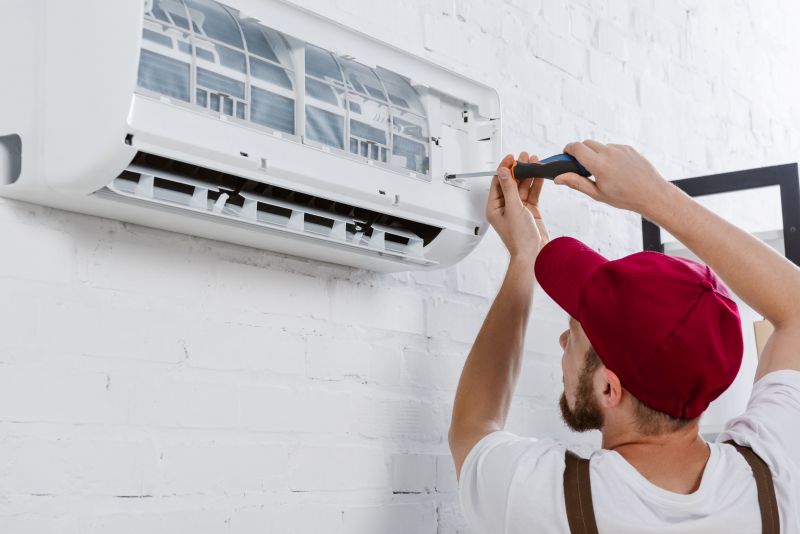Click here to get this post in PDF
If you’re planning an HVAC replacement or wondering why your old AC system can’t just get “refilled with Freon,” you’re not alone. The refrigerant replacement game has changed, big time. Here’s what replaced Freon, why it happened, and what it means for your next cooling system.
Why Freon Replacement Became Necessary
Freon is the trade name for a group of chlorofluorocarbon (CFC) and hydrochlorofluorocarbon (HCFC) refrigerants, most notably R-22, which was once the go-to cooling agent in residential and commercial air conditioners. It gained popularity because it was non-flammable, stable, and highly effective at absorbing and releasing heat, key traits for cooling systems.
Imagine inventing a cooling miracle in the 1930s, safe, effective, and odorless. That’s what Freon was: a game-changer, allowing ACs to become mainstream. But like many early tech marvels (asbestos, lead paint…), Freon had a hidden cost. It wasn’t just good at keeping homes cool, it was also devastating to the ozone layer, which is why regulators eventually stepped in. That’s when the push for Freon replacement began in earnest.
The Push for Refrigerant Replacement in AC Systems
The shift away from Freon was driven by its environmental impact. Specifically, Freon (R-22) contains chlorine, which, when released into the atmosphere, even in small leaks, breaks down ozone molecules. The ozone layer is what shields us from harmful UV radiation.
By the 1990s, global agreements like the Montreal Protocol set timelines for phasing out ozone-depleting substances. The U.S. banned the production and import of R-22 as of 2020, pushing manufacturers to adopt eco-friendlier refrigerants. So this wasn’t just a manufacturer choice, it was a global, government-backed environmental move, similar to the transition away from leaded gasoline or incandescent bulbs. It was part of a broader shift toward refrigerant replacement for a safer future.
But here’s what most people don’t realize: manufacturers didn’t just change refrigerants. They redesigned entire systems around new pressures, fluid dynamics, and efficiency curves. It wasn’t a patch; it was a full pivot. And consumers got better tech because of it. So when we say “Freon was phased out,” think iPhone-level leap, not a simple ingredient swap.
Common Freon Alternatives Used in Modern Units
The most common modern Freon alternative is R-410A, which contains no chlorine and doesn’t deplete the ozone layer. You’ll often see it marketed under brand names like Puron.
Even newer systems are starting to use alternative refrigerants like R-32 or R-454B, which offer lower global warming potential (GWP) than R-410A. These refrigerants are designed not only to protect the ozone layer but to minimize climate impact overall.
Efficiency and Impact of Alternative Refrigerants
In most cases, newer refrigerants are not only kinder to the planet, but also more efficient. R-410A runs at higher pressures than R-22, which improves energy efficiency in systems designed for it. R-32 and R-454B improve on this even more, allowing systems to extract more cooling power with less energy use and lower emissions. These alternative refrigerants represent the future of efficient, climate-friendly cooling.
That said, these benefits depend on the system design. An AC unit optimized for R-32 will outperform an older R-22 system even with the same BTU rating, because it uses refrigerant and compressor technology more efficiently.
Newer refrigerants move heat more efficiently, so your system doesn’t work as hard. That means lower bills, quieter runs, and a smaller footprint.
Efficiency isn’t just about ratings. It’s about the whole ecosystem, compressor match, coil design, and smart controls. And refrigerant is the fluid that ties it all together.
Using a Freon Substitute in Older Air Conditioners
Most R-22 systems can’t safely handle the higher pressure of R-410A or R-32. Retrofitting would require replacing critical components like the compressor, expansion valve, and copper tubing. There are “drop-in” Freon substitute options like R-407C, but even those need system adjustments, and they won’t match the performance or efficiency of a purpose-built system.
So, while retrofitting might be an option for short-term cooling, most HVAC pros recommend replacing the unit if it’s over 10–12 years old anyway. You’ll save on energy and avoid costly patchwork upgrades.
Identifying the Freon Replacement in Your AC
Check the nameplate, look for the outdoor AC unit’s sticker or metal plate. It usually lists the refrigerant type (e.g., R-22, R-410A). Most manuals will clearly state the refrigerant. If you’re due for an HVAC service, ask them to confirm during the visit, they’ll spot it in seconds.
If your system was installed before 2010, there’s a high chance it uses R-22. If it’s after 2015, it almost certainly runs on R-410A or better.
Choosing a New Unit with the Right Refrigerant Replacement
Choose a unit with R-32 or R-454B, which are becoming the new standards. They’re more efficient and environmentally responsible. R-410A is still common, and techs know it well, but by 2025–2030, expect the shift to newer freon replacement refrigerants to accelerate.
If possible, work with a contractor who offers next-gen refrigerant systems and explains how they affect maintenance, parts availability, and lifespan. The refrigerant you choose can affect your resale value, your repair costs, and how soon your system becomes obsolete.
Think of refrigerant like a phone charger port. If your AC uses a dying standard, you’ll find fewer parts, fewer techs who service it, and more headaches in 5 years. Go with what the industry is moving toward, not just what’s cheapest now. Ask your installer if their units are R-32 or R-454B ready. If they can’t answer, that’s your sign to keep shopping.
Also read: How Smart HVAC Technology Helps You Cut Costs
Image source: elements.envato.com

